Reading, Chesham, and Bedford Mass times, 1-14 November
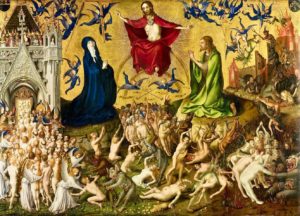
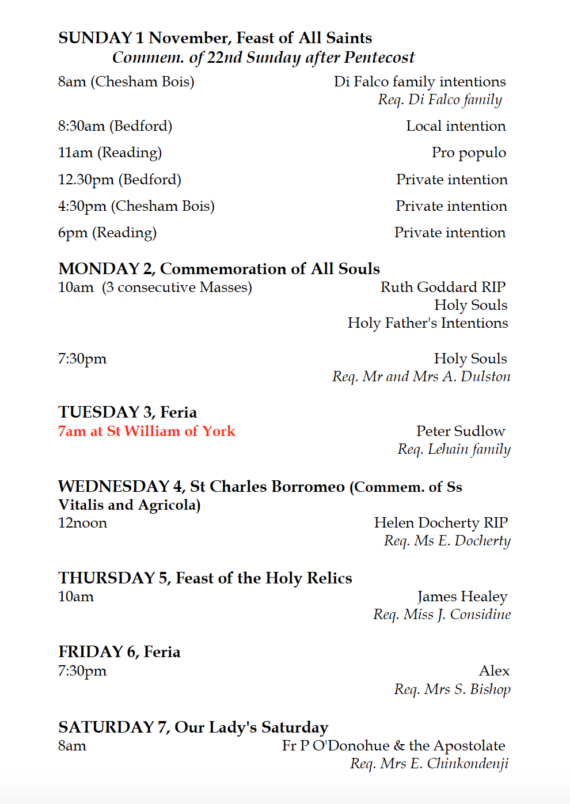
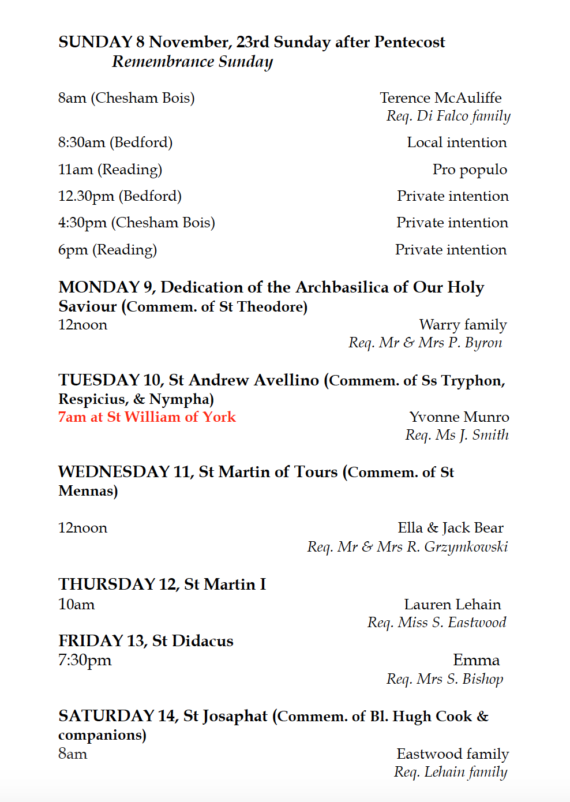
Please see the full bulletin here.



Please see the full bulletin here.
Secure now what no lockdown will ever take away from you: whether you are single or married, lay or consecrated, surrender to the Lord in loving trust. Start now.
https://www.facebook.com/londonjuventutem/videos/375918323442245

Juventutem London resumed its monthly Mass and Social in September after the lockdowns of the summer. In this video recording, Fr Armand de Malleray offers a homily to the faithful on the theme of betrothal to Christ. Fr reflects that “betrothal […] is to give ourselves completely body and soul to somebody else. For human couples in holy matrimony, this is being married and starting a family. For the individual soul, it is to surrender all that we are to the Lord, in trust that He will make use of what we are, who we are, better than if we were making the decisions.”
To see the latest newsletter, go here
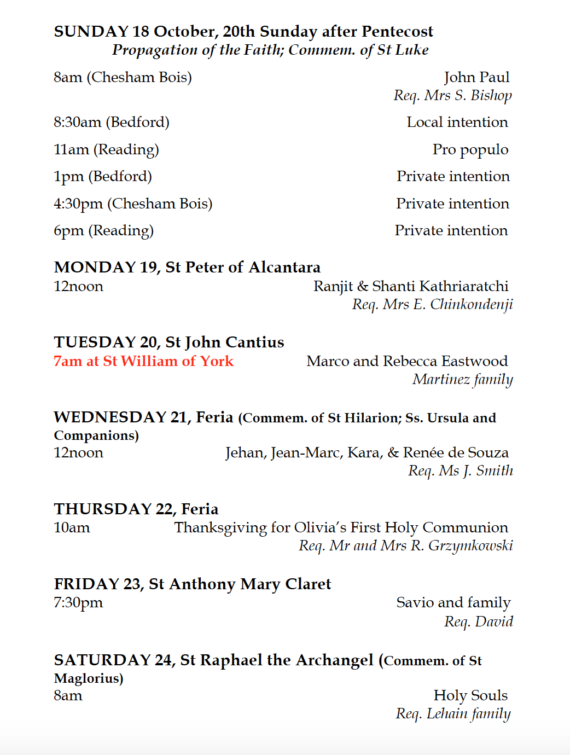

[Updated on 16th October 2020]

THANK YOU!
Priory Campaign Completed with £1m Raised
Dear Friends,
Our conveyancer emailed us today: “I am pleased to confirm that completion has taken place today.” The purchase of Priory Court Unit 1, 2 and 3 is now completed and our charity legally owns the entire building.
Our heartfelt thanks go to God and all our benefactors for the success of the Priory Campaign. The Trustees of FSSP England are delighted to announce that the remaining funds needed to complete the purchase of Priory Court (Unit 1) and to undertake the necessary conversion work have now been raised and we have ceased fundraising.
Fr Goddard, our charity’s Bursar, has written as follows: “This much needed addition to St Mary’s Shrine facilities involves significant funding, and it would not have been possible without your financial support. At the time of writing, with a few final administrative checks still to be undertaken, we are fairly certain that the Priory Campaign final total stands at £957,917.48. This includes a legacy of £139,800.00 which the executor was happy to put towards Campaign funds. When we add the expected Gift Aid rebates on some of your donations, along with other funds received towards hall facilities, this raises the total to about £1,019,300.00. With last year’s purchase of Units 2 and 3, and some remedial works completed in recent months, roughly half of this figure has been spent. However, the remaining funds will allow us to comfortably buy Unit 1 and make all the necessary conversion work and adaptions for Shrine use.”ur heartfelt thanks go to God and all our benefactors for the success of the Priory Campaign. The Trustees of FSSP England are delighted to announce that the remaining funds needed to complete the purchase of Priory Court (Unit 1) and to undertake the necessary conversion work have now been raised and we have ceased fundraising.
It seemed very fitting for us to try to buy back the old Priory and convent, both on Buttermarket Street, because they were part of St Mary’s Parish – originally owned and run by the Benedictine monks of Ampleforth Abbey. Similarly, Priory Court stands on the site of the old parish school of St Mary’s. But we started this Campaign two years ago in adverse circumstances. The owner – a large company letting office and industrial space nationwide – granted us three months, between 18th July and 18th October 2018 to raise the £1.5 million needed to make the purchases. However, with everyone going on holiday, including benefactors, this was the worst time in the year to launch a fundraising campaign. And yet, money started being sent to us.
Articles in national media such as The Catholic Herald and some international blogs draw attention to the project. The Priory Campaign received official support from The Latin Mass Society, pro-life organisations such as SPUC, 40 Days for Life, Good Counsel Network, and other prominent Catholics such as Archbishop Malcolm McMahon OP, Jacob Rees-Mogg and Viscountess Ashbrook.
The October 2018 deadline was extended over time and our scope had to be limited to the amount raised and to administrative constraints. After one year, in October 2019, we managed to buy two units of Priory Court, while allocating funds for the necessary conversion costs from office to our use. One year later, we are now completing the purchase of the final unit and can allocate space within the entire building for various needs.
Work should start shortly to make Priory Court a versatile venue for Catholic activities and events. We wish this venue to support Catholicism not only in Warrington but further afield through family activities and through liturgical, doctrinal, pro-life and artistic events. We thank wholeheartedly our benefactors, including those who offered sacrifices and prayers rather than or in addition to money, according to their means. From the start the Priory Campaign was entrusted to Our Blessed Lady. St Joseph was also regularly invoked, as well as the Servant of God Elizabeth Prout. The success of the Campaign demonstrates their blessing through the generosity of our benefactors and supporters. In happy contrast with the sad departure of the Benedictine monks from Downside Abbey in the news recently, the success of the Priory Campaign speaks of the reclamation of part of Warrington’s Benedictine patrimony. The Abbey of Ampleforth in Yorkshire used to run four parishes in Warrington. St Mary’s was the last one they had to relinquish, due to lack of vocations. There is something symbolic in the saving of St Mary’s Church from likely closure in 2015, followed by the reclaiming of the site of the old parish school next door. To English Catholics and to anyone in love with our Catholic heritage and faith, it speaks of hope, of ardour and of trust in the Lord and His saints, helping us rebuild Our Lady’s Dowry.
Special intercessor:
Born in Shrewsbury, the Servant of God Elizabeth Prout (1820-1864) founded the female branch of the Passionists with Bl. Dominic Barberi. Her congregation served deserving families in the North West. The Sisters of the Cross and Passion of Our Lord Jesus Christ arrived in Warrington on 3 January 1899. Their convent, 80 Buttermarket Street, was beside St Mary’s Benedictine Priory. They came to teach, to visit sick and needy parishioners, to instruct converts and to help the poor. The Sisters taught in St Mary’s girls’ and infants’ schools from 1899 to 1967. Her congregation now asks to be informed of any favour granted specifically through her intercession. This could lead to her beatification. In anticipation of the 200th anniversary of her birth this September, less than a month before the fundraising deadline for our Campaign, the following petition was suggested: “Servant of God Elizabeth Prout, to further your work of Catholic education and assistance to Catholic families in our country so much in need of it, please obtain from God’s Providence the successful completion of the Priory Campaign in Warrington, on the very location where your Sisters served for seven decades.”
Dear benefactors, while the Priory Campaign is satisfactorily ended, please continue to pray and support us in our ongoing expenses. To give you a recent example, the cost of a necessary Visual Condition survey (N.B. not including yet any repair) of St Mary’s church roof, tower and external areas amounts to £12,447.30 incl. VAT. The body of Elizabeth Prout lies at the Sutton St Helens Passionist Shrine, fifteen minutes from St Mary’s, along the bodies of Bl. Dominic Barberi and Ven. Ignatius Spencer. What a grace if this saintly woman could be beatified soon and intercede even more powerfully for our service to souls at Priory Court and St Mary’s. God bless you! □
After Easter during lockdown, three conferences were broadcast at St Mary’s Warrington on the Stabat Mater.

See typed presentation further below.
[Conference 1 is not available yet as the file seems to have been corrupted but might be retrieved later on.]
Conference 2:
StabatMater-II Fr. de Malleray from LiveMass on Vimeo.
Conference 3:
StabatMater-III Fr. de Malleray, FSSP from LiveMass on Vimeo.
The Stabat Mater describes the gradual acknowledging of guilt through the establishing of a filial relationship between the penitent onlooker and the Mournful Mother, leading to a brotherly relationship with Christ recognised as the Brother we slew and as the Messiah who saves. This will be manifested through the awakening of the moral conscience. Let us present more in detail each of the three parts.
Part One: The Stabat Mater teaches us to say ‘I’. What ‘I’ will speak, though? Not our inflated ego, inherited from the sinful pride of Adam and Eve. Not the rebellious ‘I’, setting itself against the divine Father and trampling underfoot God’s law of life in hellish brag: “I shall not serve!” Instead, the humble and filial ‘I’ will speak: that ‘I’ healed through contrition confessed and through filiation restored, as illustrated by the parable of the Prodigal Son: “Father, I have sinned against heaven and before thee” (Lk 15:18). In that perspective, the anonymity of the narrator in Part One is loaded with deep meaning. No one says ‘I’ in Part One. No one dares or is able to take ownership for the words spoken. The vacant identity of the narrator indicates that sin has nearly killed the moral conscience. It is too weak to act. This stage could be called purgative. The selfish ego is incapacitated by the display of the Mother’s sorrow. That sinful ego is silenced by the detailed description of what the innocent Lady endures. And yet, already it benefits from absorbing the bitter depiction of the Sorrowful Mother. These stanzas correct the selfish use of emotions. They turn sentimentality into sensitivity, mere consciousness into conscience and mind into soul.
Part Two: Following this purgation, an essential improvement occurs in the healing process with Part Two. One could name this stage illuminative. A relationship is established. It connects the onlooker and the contemplated Mother, as he now comes to realise. No longer anonymous, he discovers his identity as her son, bearing responsibility for her sufferings since her Crucified One endures them for his sake. The gradual admitting of his personal guilt is painful. But to the soul’s surprise, this realisation does not crush it but liberates it. Where he expected to find a harsh or exacting judge, the penitent can only contemplate a beautiful Woman in tears. He dreaded having his pride humiliated, and instead he only finds his conscience pricked. If this revelation hurts, as he experiences, it also heals. This new filiation instils in the soul a peace subtle but all-powerful, a joy discreet but unmistakable. Those consign to oblivion the coarse pleasures of sin, held up to then as the measure of human fulfilment. The unidentified self of Part One grows into the self-confessed penitent son of the Mother in Part Two. This leads him to addressing her divine Son in Part Three.
Part Three: The Sorrowful Mother acted as a protective lens between the dying ego and Christ, Splendour of the Father. Now is the unitive stage, between the soul and Christ. Like the Blue Madonna on the Great Window of the Chartres Cathedral, the Mater Dolorosa spread as a merciful prism, granting time for the eyes of the muddy pilgrim to open wider and to welcome the blazing beams of the Sun of Justice, Jesus the Saviour. Thus is the personal and direct encounter between the penitent soul and Christ made possible in the last two stanzas of the Stabat Mater. We should not take for granted our relationship with Christ. While He (and his Mother) always will it for our good, we sinners need all their care to understand and accept it. If the penitent is emboldened to address Christ directly in Part Three, such improvement is necessarily owed to the Mother’s intercession in Part One and Two. Without it, the soul would proudly deny its guilt or collapse in dire shame at the mere thought of a direct contact with her Son, now undeniably identified as the God pierced by our sins. And yet, out of necessity for salvation, the guilty soul must relate to Christ, the only Saviour of men. Becoming child of Mary was the only way. Marian filiation is the mode allowing personal encounter with Christ. Since the crucified Saviour is also and supremely Son of the Virgin, kinship gives the penitent assurance of mercy. Brotherhood bodes well of pardon.
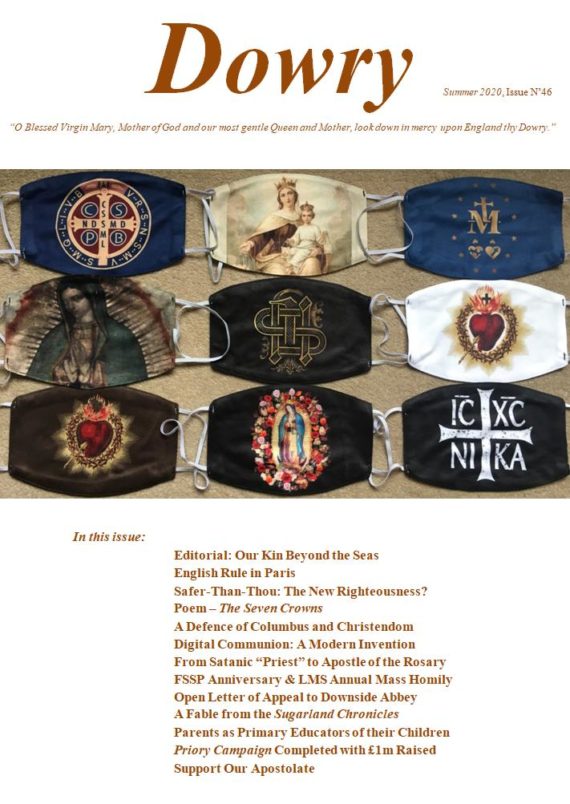
In this issue:
If you have subscribed (for free) to Dowry, the printed version will be sent to you this month. You can also have it emailed to you here. Tell your friends!

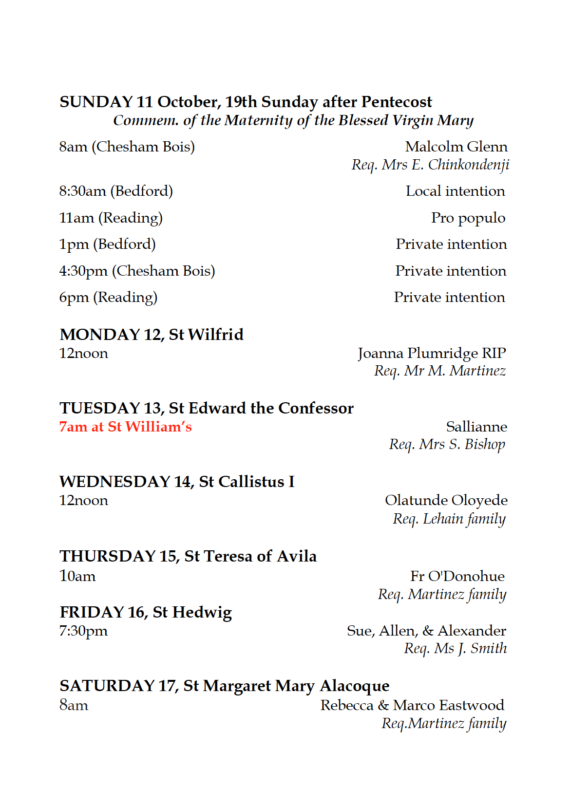
Please click here to read the latest bulletin.

You have seven days left to contribute, here:
Let us make our voices heard while there is time.
Our peak live audience on LiveMass was on Maundy Thursday 2020 with 1,754 households connected.
Listen to the nine-minute homily by Fr Alex Stewart, FSSP, freshly uploaded here: https://vimeo.com/455615905
Maundy Thursday 2020 from LiveMass on Vimeo.